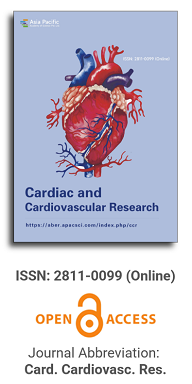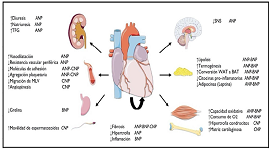
Asia Pacific Academy of Science Pte. Ltd. (APACSCI) specializes in international journal publishing. APACSCI adopts the open access publishing model and provides an important communication bridge for academic groups whose interest fields include engineering, technology, medicine, computer, mathematics, agriculture and forestry, and environment.

Research progress and controversy on T wave formation mechanism
Vol 2, Issue 2, 2021
Download PDF
Abstract
Although ECG has been developed for a hundred years, the mechanism of T wave formation is unknown. The proposal of in vitro wedge-shaped model has greatly promoted the understanding of T-wave formation mechanism. By comparing the action potentials of epicardial cells, medial cells and endocardial cells in wedge-shaped ventricular mass with the T wave of body surface ECG, it was found that the T wave was mainly formed by the dispersion of transmural repolarization of ventricular muscle. However, in the subsequent in vivo experiments, electrophysiologists found that the formation of T wave was related to the dispersion of ventricular global repolarization, and the repolarization order of different parts of the three-dimensional global heart determined the polarity of T wave. In the real heart, the mechanism of T wave formation may be more complex, its repolarization gradient may include repolarization in each axis of the heart, and the polarity of T wave may also be the result of multiple factors.
Keywords
References
- Noble D, Cohen I. The interpretation of the T wave of the electrocardiogram. Cardiovascular Research. 1978; 12(1): 13-27. doi: 10.1093/cvr/12.1.13
- Burdon-Sanderson J. On the electrical phenomena of the excitatory process in the heart of the frog and of the tortoise, as investigated photographically. The Journal of Physiology. 1884; 4(6): 327-386. doi: 10.1113/jphysiol.1884.sp000134
- Cohen I, Giles W, Noble D. Cellular basis for the T wave of the electrocardiogram. Nature. 1976; 262(5570): 657-661. doi: 10.1038/262657a0
- Sicouri S, Antzelevitch C. A subpopulation of cells with unique electrophysiological properties in the deep subepi-cardium of the canine ventricle. The M cell. Circulation Research. 1991; 68(6): 1729-1741. doi: 10.1161/01.res.68.6.1729
- Sicouri S, Fish J, Antzelevitch C. Distribution of M cells in the canine ventricle. Journal of Cardiovascular Electro-physiology. 1994; 5(10): 824-837. doi: 10.1111/j.1540-8167.1994.tb01121.x
- Antzelevitch C, Fish J. Electrical heterogeneity within the ventricular wall. Basic Research in Cardiology. 2001; 96(6): 517-527. doi: 10.1007/s003950170002
- Yan GX, Antzelevitch C. Cellular basis for the normal T wave and the electrocardiographic manifestations of the long-QT syndrome. Circulation. 1998; 98(18): 1928-1936. doi: 10.1161/01.cir.98.18.1928
- Emori T, Antzelevitch C. Cellular basis for complex T waves and arrhythmic activity following combined I(Kr)and I(Ks) block. Journal of Cardiovascular Electrophysiology. 2001; 12(12): 1369-1378. doi: 10.1046/j.1540-8167.2001.01369.x
- Xia Y, Liang Y, Kongstad O, et al. Tpeak-Tend interval as an index of global dispersion of ventricular repolarization: evaluations using monophasic action potential mapping of the epi-and endocardium in swine. Journal of Inter-ventional Cardiac Electrophysiology. 2005; 14(2): 79-87. doi: 10.1007/s10840-005-4592-4
- Xia Y, Liang Y, Kongstad O, et al. In vivo validation of the coincidence of the peak and end of the T wave with full repolarization of the epicardium and endocardium in swine. Heart Rhythm. 2005; 2(2): 162-169. doi: 10.1016/j.hrthm.2004.11.011
- Janse MJ, Sosunov EA, Coronel R, et al. Repolarization gradients in the canine left ventricle before and after in-duction of short-term cardiac memory. Circulation. 2005; 112(12): 1711-1718. doi: 10.1161/circulationaha.104.516583
- Opthof T, Coronel R, Wilms-Schopman FJ, et al. Dispersion of repolarization in canine ventricle and the electro-cardiographic T wave: Tp-e interval does not reflect transmural dispersion. Heart Rhythm. 2007; 4(3): 341-348. doi: 10.1016/j.hrthm.2006.11.022
- Janse MJ, Coronel R, Opthof T, et al. Repolarization gradients in the intact heart: transmural or apico-basal? Progress in Biophysics and Molecular Biology. 2012; 109(1-2): 6-15. doi: 10.1016/j.pbiomolbio.2012.03.001
- Coronel R, de Bakker JM, Wilms-Schopman FJ, et al. Monophasic action potentials and activation recovery in-tervals as measures of ventricular action potential duration: experimental evidence to resolve some controversies. Heart Rhythm. 2006; 3(9): 1043-1050. doi: 10.1016/j.hrthm.2006.05.027
- Taccardi B, Punske BB, Sachse F, et al. Intramural activation and repolarization sequences in canine ventricles. Experimental and simulation studies. Journal of Electrocardiology. 2005; 38(4): 131-137. doi: 10.1016/j.jelectrocard.2005.06.099
- Meijborg VM, Conrath CE, Opthof T, et al. Electrocardiographic T wave and its relation with ventricular repolari-zation along major anatomical axes. Circulation: Arrhythmia and Electrophysiology. 2014; 7(3): 524-531. doi: 10.1161/circep.113.001622
- Opthof T, Remme CA, Jorge E, et al. Cardiac activation-repolarization patterns and ion channel expression mapping in intact isolated normal human hearts. Heart Rhythm. 2017; 14(2): 265-272. doi: 10.1016/j.hrthm.2016.10.010
- Ghanem RN, Burnes JE, Waldo AL, et al.Imaging dispersion of myocardial repolarization, II: noninvasive recon-struction of epicardial measures. Circulation. 2001; 104(11): 1306-1312. doi: 10.1161/hc3601.094277
- Ramanathan C, Jia P, Ghanem R, et al. Activation and repolarization of the normal human heart under complete physiological conditions. Proceedings of the National Academy of Sciences. 2006; 103(16): 6309-6314. doi: 10.1073/pnas.0601533103
- Meijborg VM, Chauveau S, Janse MJ, et al. Interventricular dispersion in repolarization causes bifid T waves in dogs with dofetilide-induced long QT syndrome. Heart Rhythm. 2015; 12(6): 1343-1351. doi: 10.1016/j.hrthm.2015.02.026
- Arteyeva NV, Goshka SL, Sedova KA, et al. What does the T (peak)-T(end)interval reflect? An experimental and model study. Journal of Electrocardiology. 2013; 46(4): 296.e1-296.e8. doi: 10.1016/j.jelectrocard.2013.02.001
- Xia Y, Yang Y. The electrophysiological mechanism of T wave formation and its controversy. Progress in cardiology. 2010; 31(04): 497.
- Boukens BJ, Meijborg VMF, Belterman CN, et al. Local transmural action potential gradients are absent in the isolated, intact dog heart but present in the corresponding coronary-perfused wedge. Physiological Reports. 2017; 5(10): e13251. doi: 10.14814/phy2.13251
- Yuan S, Kongstad O, Hertervig E, et al. Global repolarization sequence of the ventricular endocardium: monophasic action potential mapping in swine and humans. Pacing and Clinical Electrophysiology. 2001; 24(10): 1479-1488. doi: 10.1046/j.1460-9592.2001.01479.x
- Conrath CE, Wilders R, Coronel R, et al. Intercellular coupling through gap junctions masks M cells in the human heart. Cardiovascular Research. 2004; 62(2): 407-414. doi: 10.1016/j.cardiores.2004.02.016
- Mines GR. On functional analysis by the action of electrolytes. The Journal of Physiology. 1913; 46(3): 188-235. doi: 10.1113/jphysiol.1913.sp001588
- Wilson FN. The T deflection of the electrocardiogram. Trans Assn Am Physicians. 1931; 46: 29.
- Higuchi T, Nakaya Y. T wave polarity related to the repolarization process of epicardial and endocardial ventricular surfaces. American Heart Journal. 1984; 108(2): 290.
- Cowan JC, Hilton CJ, Griffiths CJ, et al. Sequence of epicardial repolarisation and configuration of the T wave. Heart. 1988; 60(5): 424-433. doi: 10.1136/hrt.60.5.424
- Opthof T, Janse MJ, Meijborg VM, et al. Dispersion in ventricular repolarization in the human, canine and porcine heart. Progress in Biophysics and Molecular Biology. 2016; 120(1-3): 222-235. doi: 10.1016/j.pbiomolbio.2016.01.007
- Maffessanti F, Wanten J, Potse M, et al. The relation between local repolarization and T-wave morphology in heart failure patients. International Journal of Cardiology. 2017; 241: 270-276. doi: 10.1016/j.ijcard.2017.02.056
Supporting Agencies
Copyright (c) 2021 Cheng Chen, Yunlong Xia

This work is licensed under a Creative Commons Attribution 4.0 International License.

This site is licensed under a Creative Commons Attribution 4.0 International License (CC BY 4.0).

Prof. Prakash Deedwania
University of California,
San Francisco, United States




